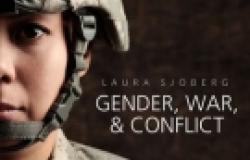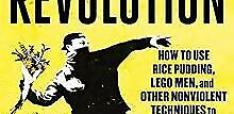Book Review: Gender, War, and Conflict

Gender, War, and Conflict by Laura Sjoberg. Cambridge / Malden MA: Polity Press, 2014. 202 pp, £50 / €62.50 hardcover 978-0-7456-6001-1, £14.99 / €18.80 paperback 978-0-7456-6002-8, £13.99 / €16.99 e-book 978-0-7456-8467-3
This feminist text on International Relations aims at stimulating debates about the gendered nature and dynamics of war and war-making, and providing tools for a gendered analysis of war and conflict. Laura Sjoberg, an Associate Professor of Political Science at the University of Florida, takes as her departure point the increased presence of women in war theatres of operation, that challenges some of the most straightforward assumptions and gendered assigned roles of men and women in war. However, the mere presence of women is not enough to contest the well-grounded gendered links between masculinities and warfare that sustain the current understanding (and conduct) of war. Sjoberg argues that gender analysis is an inescapable imperative for those seeking to understand the causes, dynamics and consequences of war and conflict: “War is gendered, and gender constructions are built at least in part on the dynamics of war and conflict” (p. 12).
This volume reviews some of the essential works of feminist scholarship in IR, and provides a useful addition with two primary interests in mind. First it seeks to understand where women and gender are in war and conflict (and, relatedly, why they are often omitted from most analyses of those phenomena). Second, it draws attention to (and redresses) gender subordination both in war and conflict, and in scholarship on them.
A crucial enquiry that permeates this book is the treatment of women (and men) in war narratives. The classic question in feminist studies is: Where are the women? In war accounts, the role of women is largely invisible. Despite the fact that they have been combatants in many wars, this role is largely neglected. Even when recognized, it is minimized as they are differentiated as women soldiers (not soldiers), women revolutionaries (not revolutionaries), or women terrorists (not terrorists) (p. 40). Other roles, including the provision of vital support services, participation in war economies, or political organizing, are also left aside. The gendered construction of war reduces the role of women to persons in need of protection (with this construction becoming, in fact, one if not the foremost justification for war). The notions of innocent and helpless women are a crucial part of the ways in which both soldiers and states justify war.
Sjoberg then rightly moves to question where are the men? Of course, their presence is widespread in war narratives, but it is presented only in stylized roles of heroic combatants: roles that conform with (and reinforce) gender expectations about what men are and how they behave in war. The result is the invisibility of other roles played by many men during wars, including being civilians, as they contradict the masculinities accepted in these narratives. Men who do not conform to the traditional notions of masculinities in conflict are also invisible in war stories. This factor is complementary to the gendered process that transforms an ordinary boy or man into a soldier (a reliable killer), heavily based on these masculinity roles.
Arguing that the debate must go beyond men and women, Sjoberg introduces the element of diverse gender identities and sexualities in Chapter 4, incorporating insights from Queer Theory and Transgender Theory. This is, however, the less developed chapter and the issues are only covered superficially. In Chapter 5, the author argues that this approach is an opportunity to rethink the concept of war, which she proposes to redefine according to three key elements: war as a continuum (instead of a one-off event), war as an experiential approach, and an understanding of war stories as gendered stories.
The closing chapter, “War(s) as if Gender Mattered”, contains an analysis of the methodological, empirical and theoretical basis that would allow a gendered analysis of war and International Relations. The author suggests methods of mainstreaming gender in thinking about war and conflict by asking the right questions (and asking them well), using an array of research tools with these questions in mind, and analysing why war stories, practices, and research have gendered omissions and who benefits from them. Mainstreaming in thinking, she suggests, should be followed by a similar process in war-related theorizing and policy making. For Sjoberg, gender analysis can change how we think about war and, as a result, IR and other disciplines: such analysis being the first steps in an attempt to alter policy-making for the better.
Among the many case studies included in this book, this reviewer would like to mention two, for their overall significance in the context of the volume. The first, “Gender and the Chechen Wars” (pp. 13-14) makes first a ‘standard’ account of these wars similar to what one can find in most media or scholarly analysis (with no mention of women, men, or gender). Then the author conducts a brief review of feminist literature that provides a very different account, by unpacking how gender dynamics in Russia and in Chechnya, and between them, contributed to the evolution of the conflict.
A second case explains how US troops in Afghanistan and Iraq, and the remote attacks with drones in the context of the “war on terror,” share a conception in which MAM (Military-Age Male) are all considered combatants. In the case of drone attacks, this approach includes counting civilian casualties by systematically excluding these men, and has been sanctioned by the Obama Administration (pp. 58-59).
This book is a helpful guide to the field aimed at scholars, professors, and students. Sjoberg reviews the literature of gender studies on war, as well as the absence of this perspective in the outstanding works of International Relations (irrespective of the school to which they belong), notes key issues and provides a wide array of cases from historical and current conflicts around the world. At the end of each chapter, she presents a list of further readings, web resources, and questions to be used in teaching and workshop formats. The volume combines intellectual depth with an accessible structure and narrative.
Mabel González Bustelo is an international advisor and consultant in peace and security, and Fellow of the Global South Unit for Mediation (BRICS Policy Center, Brazil).


